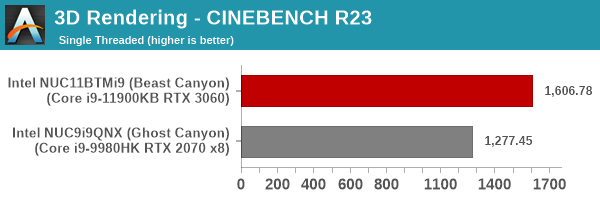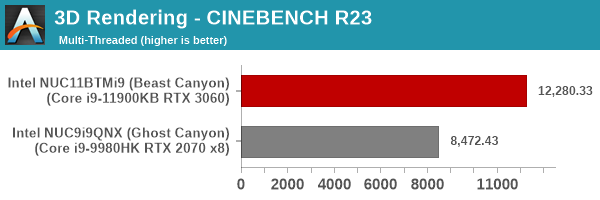Intel Beast Canyon NUC Review: Desktop Tiger Lake Debuts in SFF Gaming Powerhouse
by Ganesh T S on July 29, 2021 9:00 AM EST- Posted in
- Systems
- Intel
- NUC
- Tiger Lake
- NUC11
- Beast Canyon
Miscellaneous Performance Metrics
This section looks at some of the other commonly used benchmarks representative of the performance of specific real-world applications.
Web Browser Benchmarks - JetStream and Speedometer
Web browser-based workloads have emerged as a major component of the typical home and business PC usage scenarios. Beginning with this review, we are including browser-focused benchmarks from the WebKit developers. Hosted at BrowserBench, JetStream 2.0 benchmarks JavaScript and WebAssembly performance, while Speedometer measures web application responsiveness. We also process MotionMark, but the confidence level of the results vary as much as +/-35%. Hence, we present graphs only the Jetstream 2.0 and Speedometer results for the three top browsers below.


In order to maintain reproducibility, we self-host the BrowserBench benchmarks (git clone of the WebKit repository as on July 1, 2021). The browser versions used for the numbers above are presented in the table included in each system's review.
| Intel NUC11BTMi9 Browser Bench | |||
| Speedometer 2.0 | JetStream 2.0 | MotionMark 1.2 | |
| Microsoft Edge (92.0.902.55) |
181 ± 2.2 | 201.313 | 900.46 ± 14.16% |
| Google Chrome (92.0.4515.107) |
212.1 ± 2.1 | 201.097 | 1115.74 ± 5.54% |
| Mozilla Firefox (90.0.2.7872) |
164 ± 2.2 | 123.612 | 1072.12 ± 3.44% |
BAPCo's SYSmark 25 and UL's PCMark benchmarks both include web browser activities as part of their evaluation scheme. However, the performance for this increasingly important workload tends to get lost in the presentation of a single number. JetStream and Speedometer help us focus on how different PC configurations vary in terms of the user experience with respect to web browsers.
3D Rendering - CINEBENCH R23
We use CINEBENCH R23 for 3D rendering evaluation. R23 provides two benchmark modes - single threaded and multi-threaded. Evaluation of different PC configurations in both supported modes provided us the following results.


The microarchitectural improvements in Tiger Lake help the Beast Canyon outscore the Ghost Canyon by a significant margin.
x265 Benchmark
Next up, we have some video encoding benchmarks using x265 v2.8. The appropriate encoder executable is chosen based on the supported CPU features. In the first case, we encode 600 1080p YUV 4:2:0 frames into a 1080p30 HEVC Main-profile compatible video stream at 1 Mbps and record the average number of frames encoded per second.

Our second test case is 1200 4K YUV 4:2:0 frames getting encoded into a 4Kp60 HEVC Main10-profile video stream at 35 Mbps. The encoding FPS is recorded.

The latest Tiger Lake microarchitecture again helps the Beast Canyon come out on top.
7-Zip
7-Zip is a very effective and efficient compression program, often beating out OpenCL accelerated commercial programs in benchmarks even while using just the CPU power. 7-Zip has a benchmarking program that provides tons of details regarding the underlying CPU's efficiency. In this subsection, we are interested in the compression and decompression rates when utilizing all the available threads for the LZMA algorithm.


Cryptography Benchmarks
Cryptography has become an indispensable part of our interaction with computing systems. Almost all modern systems have some sort of hardware-acceleration for making cryptographic operations faster and more power efficient. In this sub-section, we look at two different real-world applications that may make use of this acceleration.
BitLocker is a Windows features that encrypts entire disk volumes. While drives that offer encryption capabilities are dealt with using that feature, most legacy systems and external drives have to use the host system implementation. Windows has no direct benchmark for BitLocker. However, we cooked up a BitLocker operation sequence to determine the adeptness of the system at handling BitLocker operations. We start off with a 2.5GB RAM drive in which a 2GB VHD (virtual hard disk) is created. This VHD is then mounted, and BitLocker is enabled on the volume. Once the BitLocker encryption process gets done, BitLocker is disabled. This triggers a decryption process. The times taken to complete the encryption and decryption are recorded. This process is repeated 25 times, and the average of the last 20 iterations is graphed below.


Creation of secure archives is best done through the use of AES-256 as the encryption method while password protecting ZIP files. We re-use the benchmark mode of 7-Zip to determine the AES256-CBC encryption and decryption rates using pure software as well as AES-NI. Note that the 7-Zip benchmark uses a 48KB buffer for this purpose.


Yet another cryptography application is secure network communication. OpenSSL can take advantage of the acceleration provided by the host system to make operations faster. It also has a benchmark mode that can use varying buffer sizes. We recorded the processing rate for a 8KB buffer using the hardware-accelerated AES256-CBC-HAC-SHA1 feature.


In every cryptography application, the Tiger Lake-based Beast Canyon is the runaway leader.
Agisoft Photoscan
Agisoft PhotoScan is a commercial program that converts 2D images into 3D point maps, meshes and textures. The program designers sent us a command line version in order to evaluate the efficiency of various systems that go under our review scanner. The command line version has two benchmark modes, one using the CPU and the other using both the CPU and GPU (via OpenCL). We present the results from our evaluation using the CPU mode only. The benchmark (v1.3) takes 84 photographs and does four stages of computation:
- Stage 1: Align Photographs (capable of OpenCL acceleration)
- Stage 2: Build Point Cloud (capable of OpenCL acceleration)
- Stage 3: Build Mesh
- Stage 4: Build Textures
We record the time taken for each stage. Since various elements of the software are single threaded, and others multithreaded, it is interesting to record the effects of CPU generations, speeds, number of cores, and DRAM parameters using this software.




Dolphin Emulator
Wrapping up our application benchmark numbers is the new Dolphin Emulator (v5) benchmark mode results. This is again a test of the CPU capabilities.

Overall, the CPU capabilities of the Core i9-11900KB with its new Tiger Lake microarchitecture / increased L2+L3 cache help the Beast Canyon NUC handily outwit the other contenders across all the workloads analyzed in this section.










84 Comments
View All Comments
dullard - Thursday, July 29, 2021 - link
Have you actually done the math on how infrequently ECC actually helps the typical user?So what if roughly once a year, I get a one bit change in my audio for a split second, or a single pixel changed on my video, or my photo needs to load twice from Facebook, etc. Most people just don't have anything that is valuable on their personal computers any more. Almost nothing most people do now on computers will care if a memory error occurs. Combine that with the very infrequent memory errors and it just isn't a problem.
Absolute worst case scenario: I have to restore one corrupted file from backup.
With servers, ECC certainly is needed. With certain financial and security applications, ECC is definitely needed. For people to repost spam on Facebook? Nope, ECC need not found.
willis936 - Thursday, July 29, 2021 - link
Once you start climbing up the bathtub curve it isn't one bit flip every year. It's dirty bits constantly written to disk. It's a real nightmare.Spunjji - Friday, July 30, 2021 - link
"constantly"Not really
willis936 - Friday, July 30, 2021 - link
Yes, it is. I just ditched a system that could no longer install an OS without error. Memory tests hung. It wasn't the modules. Dust had shorted some memory channel pins and either damaged the motherboard or CPU.There were bad blocks all over the disk. I ran fsck to get back the user's files but there is no telling if the data's any good.
Do you even know what a bathtub curve is?
mode_13h - Monday, August 2, 2021 - link
> Have you actually done the math on how infrequently ECC actually helps the typical user?If you have bad RAM, it can be a major source of system instability. I think this is the primary benefit of ECC.
I've wasted time debugging software problems, in the past, only to find out that the problem was specific to a given machine and that machine turned out to have bad RAM. Once the DIMM indicated by memtest was replaced, the bug stopped occurring.
So, for the sake of my time and sanity, I use ECC whenever possible. Even though bad RAM isn't that common, the premium for ECC is a small price to pay for the extra margin of safety.
When ECC isn't an option, I always do an initial overnight memtest run and try to use memory rated for a higher speed than what I plan to run it at.
dullard - Thursday, July 29, 2021 - link
And the more obvious retort, this is a "SFF Gaming Powerhouse", I asked why one would want ECC for it and you reply with "should be used only in game consoles or similar applications". Seems like you missed the point of the product.If there is another use case for this product that actually needs ECC, then I'm curious to know what that use case is.
willis936 - Thursday, July 29, 2021 - link
A powerful personal computer. NUCs are made to be personal computers. If they put a big CPU and GPU in it then it's going to handle workloads thrown at it. How does ECC not fit this use case?dullard - Friday, July 30, 2021 - link
SFF works best as portable gaming and home theater uses. Neither of which have any need for ECC.I'm not saying that some computers don't need ECC. It is just that desktop computers that need ECC usually aren't physical size limited, don't need to be portable, and/or don't need full size video cards. I'm just stumped as to any real use case that actually needs that particular combo. Every use case that I can think of where ECC helps (which is not really common for personal users) either doesn't need SFF or doesn't need a large video card. It sounds much more like a wish list than a real need.
Spunjji - Friday, July 30, 2021 - link
"It sounds much more like a wish list than a real need."Bingo, but some people's wish lists are backed up by some heavy post-hoc rationalization.
willis936 - Friday, July 30, 2021 - link
This thinking is painfully flawed.You don't *need* a computer of any kind. Why bother with a smartphone or a SFF desktop?